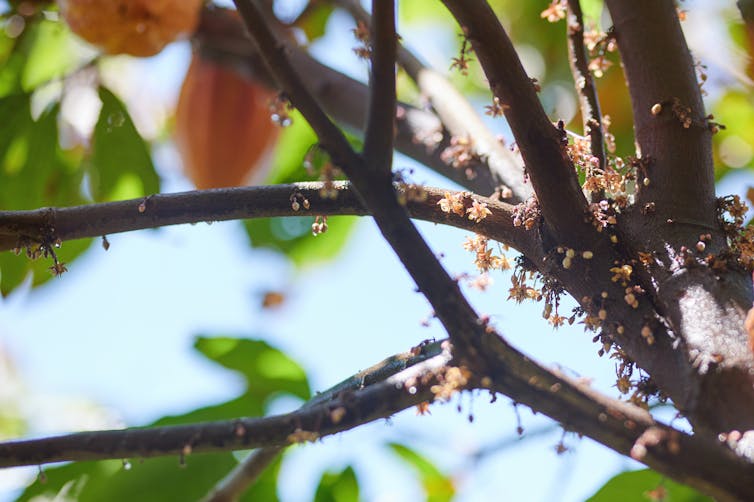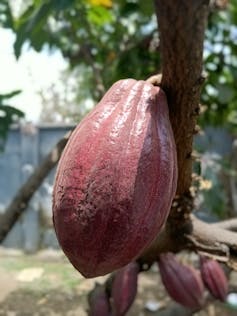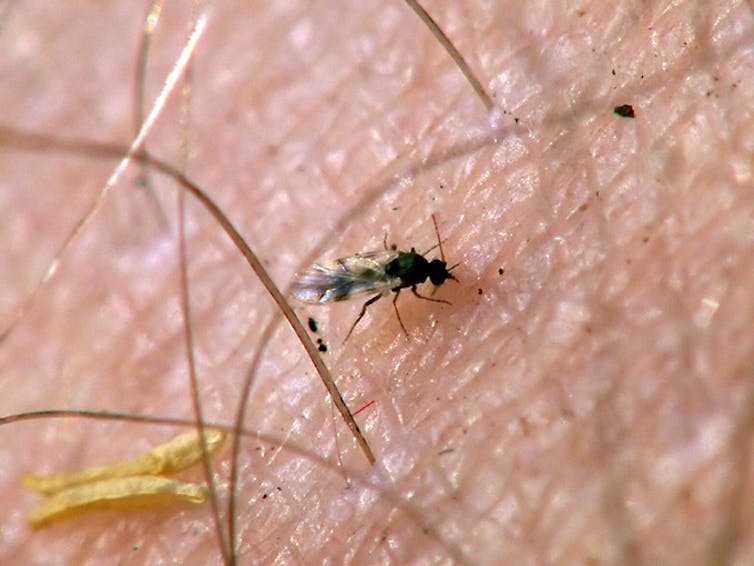Tiny cacao flowers and fickle midges are part of a pollination puzzle that limits chocolate production
- Written by DeWayne Shoemaker, Professor and Department Head, Entomology and Plant Pathology, University of Tennessee
It’s almost impossible to imagine a world without chocolate. Yet cacao trees, which are the source of chocolate, are vulnerable.
I am a passionate chocolate lover and an entomologist[1] who studies cacao pollination. The crop’s sustainability currently appears to depend on several species of tiny fly pollinators, who are frankly struggling to get the job done.
Thousands of flowers
Chocolate is derived from the seeds of the cacao tree, Theobroma cacao L., which literally means “food of the gods.” The plant originated in the Western Amazon region of South America[2] and has been cultivated for more than 3,000 years in many parts of Central and South America. Today it’s grown in equatorial regions around the world, including western Africa and several tropical regions in Asia.
 Cacao blossoms are unusual for a tree.
dimarik/iStock via Getty Images Plus[3]
Cacao blossoms are unusual for a tree.
dimarik/iStock via Getty Images Plus[3]
A mature cacao tree can produce many thousands of flowers each year. These flowers are tiny, only a half inch or so in diameter (1-2 cm). The flowers typically grow in clusters directly from the trunk of the tree or off large branches[4].
 Pods can be green, white, yellow, purplish or red in color.
Neilstha Firman/EyeEm via Getty Images[5]
Pods can be green, white, yellow, purplish or red in color.
Neilstha Firman/EyeEm via Getty Images[5]
Each flower requires pollination to successfully produce a nearly football-sized fruit – a pod containing 30-60 seeds, which can be processed to make chocolate.
It sounds straightforward but, in fact, successful cacao pollination is problematic[6] in many regions. Only around 10%-20% of the flowers produced by a cacao tree are successfully pollinated. The rest, up to 90%, never receive pollen[7] – or do not receive enough pollen to create fruits.
Scientists don’t fully understand cacao pollination, which is surprising given that over 50 million people worldwide currently depend on chocolate for their livelihood[8].
 In the U.S., some midges are better known as ‘no-see-ums.’
tompiast, CC BY-SA[9][10]
In the U.S., some midges are better known as ‘no-see-ums.’
tompiast, CC BY-SA[9][10]
A big job for a tiny fly
The insects responsible for pollinating cacao’s tiny flowers are, themselves, also tiny, in order to access the flower’s reproductive structures. Biting midges from the Ceratopogonidae family and gall midges from the Cecidomyiidae family[11] are among the most important known cacao pollinators worldwide.
The majority of cacao trees are what are known as self-incompatible[12], meaning they cannot pollinate themselves. Successful pollinators must pick up pollen from the male parts of a flower of one tree and deposit it on the female parts of a flower on another tree.
Cacao flowers are also short-lived, typically receptive to pollen for only one or two days. Flowers that do not receive ample pollen die and fall within 36 hours[13] of opening.
Evidence suggests improving midge habitat[14] can increase fruit yield. So, in some cacao-growing areas, current farming practices include developing and maintaining suitable ground habitat within and near cacao orchards in an effort to increase the number of midges capable of pollen transmission.
Lingering mysteries
The success of artificial or hand pollination[15], which can more than double yields, shows cacao trees are capable of producing many more pods than they currently do.
Workers at a cacao farm in Ghana demonstrate how they hand-pollinate the tree’s flowers.It’s hard not to wonder: Why aren’t midges doing a better job of pollinating cacao flowers? Scientists think part of the answer might be that midges don’t solely depend upon cacao flowers for their life cycle[16]. Because they can get sugar from other plant sources, they are likely passive rather than active pollinators of cacao. Scientists also wonder if they are up to the task of flying the significant distances between wild trees.
[Deep knowledge, daily. Sign up for The Conversation’s newsletter[17].]
All of which begs the question: Are there insects better designed for the job? And, if so, where did they go?
Most studies linking midges to cacao pollination were conducted in orchards, while the biology of wild cacao pollination is almost completely unstudied.
One exception is a study that looked at both cultivated and wild cacao in Bolivia[18]. It found that midges represented only 2% of all insect visitors to wild trees. Other flies and tiny wasps were more common there.
These results are intriguing and raise the possibility that one or more unknown insects are the primary pollinators of cacao in the wild. Only additional study of wild cacao may reveal if this is the case. Such information could have far-reaching implications for the chocolate industry.
References
- ^ and an entomologist (scholar.google.com)
- ^ originated in the Western Amazon region of South America (doi.org)
- ^ dimarik/iStock via Getty Images Plus (www.gettyimages.com)
- ^ directly from the trunk of the tree or off large branches (upf.com)
- ^ Neilstha Firman/EyeEm via Getty Images (www.gettyimages.com)
- ^ cacao pollination is problematic (doi.org)
- ^ up to 90%, never receive pollen (doi.org)
- ^ depend on chocolate for their livelihood (www.iisd.org)
- ^ tompiast (eol.org)
- ^ CC BY-SA (creativecommons.org)
- ^ Biting midges from the Ceratopogonidae family and gall midges from the Cecidomyiidae family (doi.org)
- ^ self-incompatible (doi.org)
- ^ die and fall within 36 hours (doi.org)
- ^ improving midge habitat (doi.org)
- ^ success of artificial or hand pollination (doi.org)
- ^ don’t solely depend upon cacao flowers for their life cycle (doi.org)
- ^ Sign up for The Conversation’s newsletter (theconversation.com)
- ^ both cultivated and wild cacao in Bolivia (doi.org)
Authors: DeWayne Shoemaker, Professor and Department Head, Entomology and Plant Pathology, University of Tennessee

